1997 CHEVROLET MALIBU oil pressure
[x] Cancel search: oil pressurePage 9 of 354
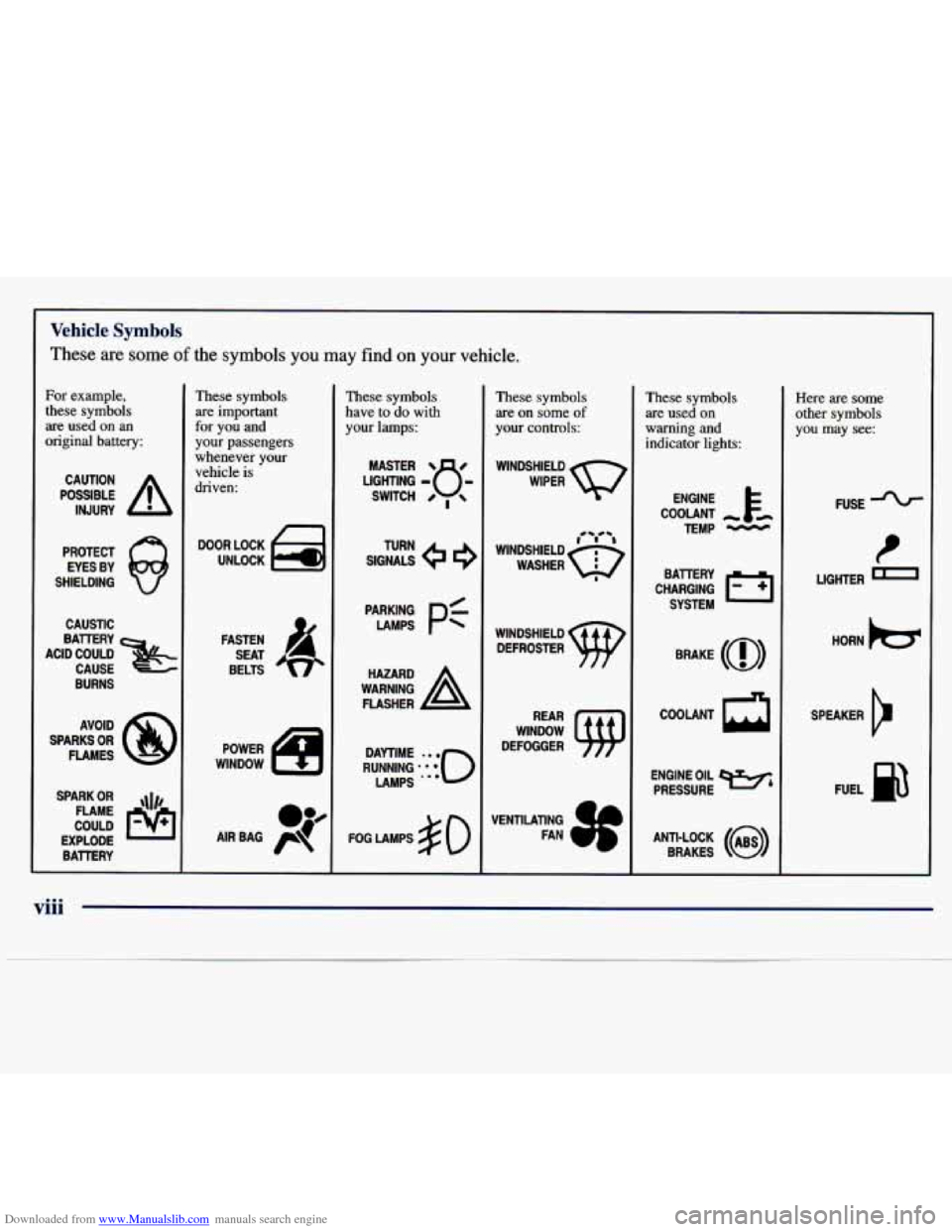
Downloaded from www.Manualslib.com manuals search engine 1
Vehicle Symbols
These are some of the symbols you may find on your vehicle.
For example,
these symbols
are used
on an
original battery:
POSSIBLE A
CAUTION
INJURY
PROTECT EYES BY
SHIELDING
Q
CAUSTIC
BURNS
AVO1 D
SPARKS
OR
FLAMES
SPARK
OR ,111,
COULD [-sr=l
FLAME
EXPLODE BAlTERY
...
These symbols
are important
for you and
your passengers
whenever your vehicle
is
driven:
DOOR LOCK
UNLOCK
These symbols
have
to do with
your lamps:
SIGNALS @ e
TURN
FOG LAMPS
$0
These symbols are
on some of
your controls:
WINDSHIELD
WIPER
WINDSHIELD DEFROSTER
WINDOW
DEFOGGER
VENTILATING FAN
These symbols
are used on
warning
and
indicator lights:
ENGINE t
COOLANT kt-
TEMP -
CHARGING I-1
BAlTERY
SYSTEM
BRAKE (@)
COOLANT a
ENGINE OIL e,
PRESSURE
ANTI-LOCK
(a)
BRAKES
Here are some
other symbols
you may see:
FUSE
P
LIGHTER
HORN
)cr
SPEAKER
Er
FUEL B
Page 117 of 354
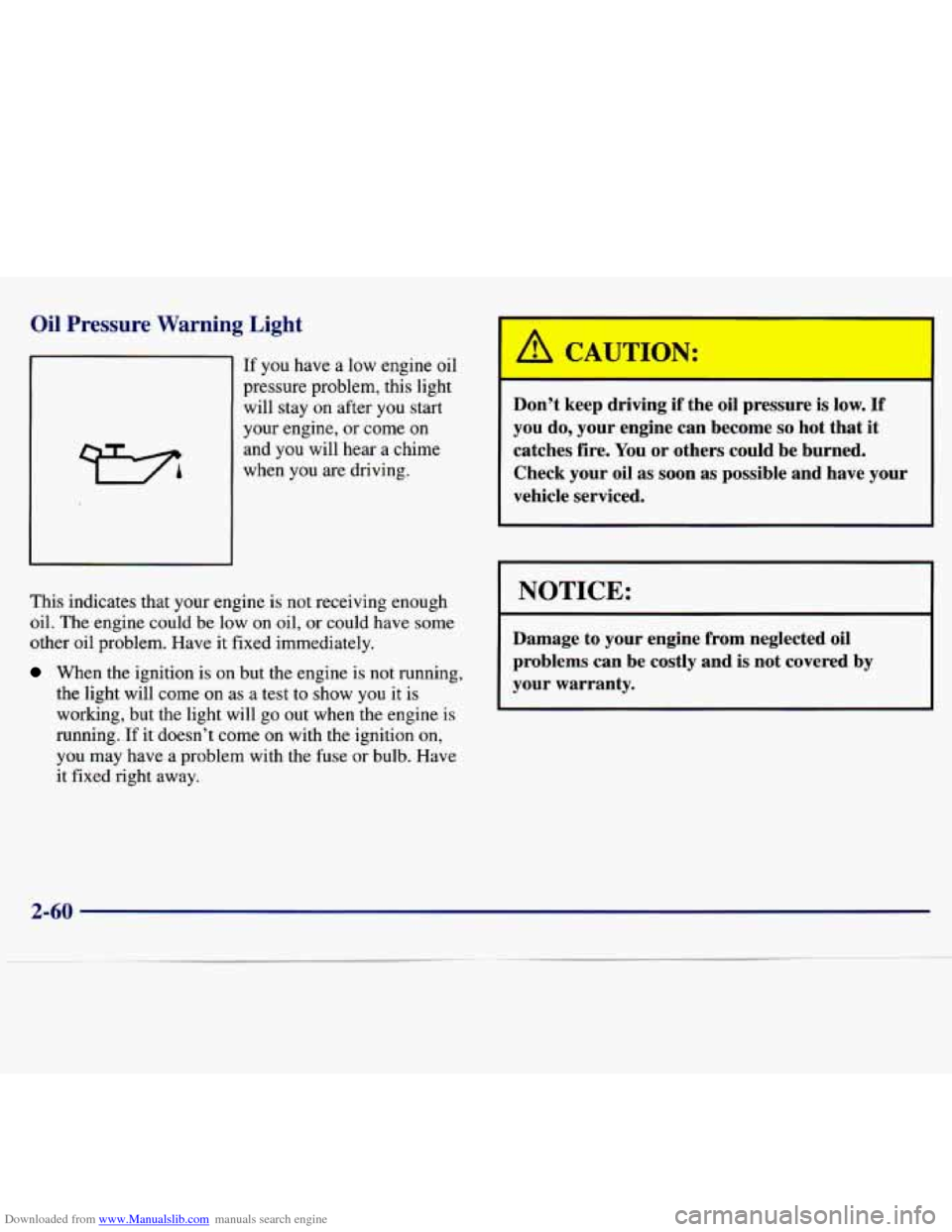
Downloaded from www.Manualslib.com manuals search engine Oil Pressure Warning Light
If you have a low engine oil
pressure problem, this light
will stay
on after you start
your engine, or come on
and you will hear a chime
when you are driving.
This indicates that your engine
is not receiving enough
oil. The engine could be low on
oil, or could have some
other oil problem. Have it fixed immediately.
When the ignition is on but the engine is not running,
the light will come on as
a test to show you it is
working, but the light will go out when the engine is
running.
If it doesn’t come on with the ignition on,
you may have a problem with the fuse or bulb. Have
it fixed
right away.
J:
Don’t keep driving if the oil pressure is low. If
you
do, your engine can become so hot that it
catches fire.
You or others could be burned.
Check your oil as soon as possible and have your
vehicle serviced.
I NOTICE:
Damage to your engine from neglected oil problems can be costly and is not covered by
your warranty.
2-60
Page 168 of 354

Downloaded from www.Manualslib.com manuals search engine The exit speed is usually posted.
Reduce your speed according to your speedometer, not to your sense
of motion. After driving for any distance
at higher speeds, you may tend to think you
are going
slower than you actually are.
Before Leaving on a Long Trip
Make sure you’re ready. Try to be well rested. If you
must start when you’re not fresh
-- such as after a day’s
work -- don’t plan to make too many miles that first part
of the journey. Wear comfortable clothing and shoes you
can easily drive in.
Is your vehicle ready for a long trip? If you keep
it
serviced and maintained, it’s ready to go. If it needs
service, have it done before starting out. Of course,
you’ll find experienced and able service experts
in
Chevrolet dealerships all across North America. They’ll
be ready and willing to help if you need it. Here
are some things you can check before a trip:
0
0
0
0
0
0
Windshield Washer Fluid: Is the reservoir full? Are
all windows clean inside and outside?
Wiper Blades: Are they in good shape?
Fuel, Engine Oil, Other Fluids: Have you checked
all levels?
Lamps: Are they all working? Are the lenses clean?
Tires: They are vitally important to a safe,
trouble-free trip. Is the tread good enough for
long-distance driving? Are the tires all inflated to the
recommended pressure?
Weather Forecasts: What’s the weather outlook
along your route? Should you delay your trip a
short
time to avoid a major storm system?
Maps: Do you have up-to-date maps?
4-21
Page 266 of 354

Downloaded from www.Manualslib.com manuals search engine 5. If a ring forms after spot cleaning, clean the entire
area immediately or it will set.
Using Foam-Type Cleaner on Fabric
1. Vacuum and brush the area to remove any loose dirt.
2. Always clean a whole trim panel or section. Mask
3. Mix Multi-Purpose Powdered Cleaner following the surrounding
trim along stitch or welt lines.
directions on the container label.
4. Use suds only and apply with a clean sponge. Don’t
saturate the material and don’t rub
it roughly.
5. As soon as you’ve cleaned the section, use a sponge
to remove the suds.
6. Rinse the section with a clean, wet sponge.
7. Wipe off what’s left with a slightly damp paper towel
8. Dry it immediately with a blow dryer.
9. Wipe with a clean cloth.
or
cloth.
Using Solvent-Type Cleaner on Fabric
First, see if you have to use solvent-type cleaner at all.
Some spots and stains will clean off better with just
water and mild soap.
If you need to use a solvent:
1. Gently scrape excess soil from the trim material with
a clean, dull knife or scraper.
2. Use very little cleaner, light pressure and clean cloths
(preferably cheesecloth). Cleaning should start at the
outside
of the stain, “feathering” toward the center.
3. Keep changing to a clean section of the cloth.
4. When you clean a stain from fabric, immediately
dry the area with a blow dryer to help prevent a
cleaning ring.
6-45
Page 270 of 354

Downloaded from www.Manualslib.com manuals search engine High pressure car washes may cause water to enter
your vehicle.
Cleaning Exterior LampsLenses
Use lukewarm or cold water, a soft cloth and a liquid
hand, dish or vehicle washing (mild detergent) soap to
clean exterior lamps and lenses. Follow instructions
under “Washing Your Vehicle.”
Finish Care
Occasional waxing or mild polishing of your Chevrolet
by hand may be necessary to remove residue fkom the
paint finish. You can get GM-approved cleaning
products from your dealer. (See “Appearance Care and
Materials” in the Index.)
Your Chevrolet has a “basecoatklearcoat” paint finish.
The clearcoat gives more depth and gloss to the colored
basecoat. Always use waxes and polishes that are non-abrasive and made for a basecoatklearcoat
paint finish.
NOTICE:
Machine compounding or aggressive polishing on
a basecoat/clearcoat paint finish may dull the
finish or leave swirl marks.
Foreign materials such as calcium chloride and other salts, ice melting agents, road oil and tar, tree sap, bird
droppings, chemicals from industrial chimneys, etc., can
damage your vehicle’s finish if they remain on painted surfaces. Wash the vehicle as soon as possible.
If
necessary, use non-abrasive cleaners that are marked
safe for painted surfaces to remove foreign matter.
Exterior painted surfaces are subject to aging, weather and chemical fallout that can take their toll over a period
of years. You can help to keep the paint finish looking
new by keeping your Chevrolet garaged or covered
whenever possible.
6-49
Page 320 of 354
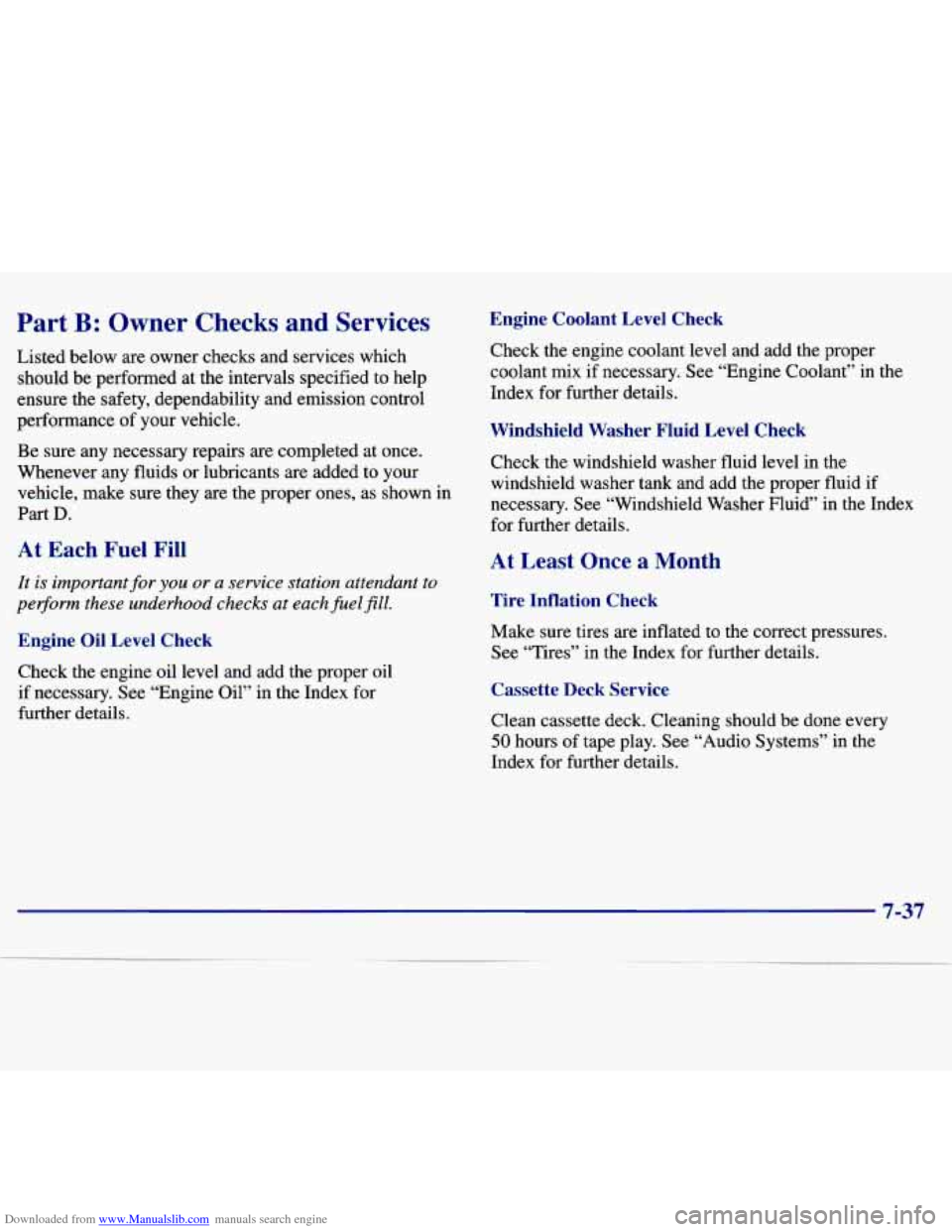
Downloaded from www.Manualslib.com manuals search engine Part B: Owner Checks and Services
Listed below are owner checks and services which
should be performed at the intervals specified to help
ensure the safety, dependability and emission control
performance of your vehicle.
Be sure any necessary repairs
are completed at once.
Whenever any fluids or lubricants
are added to your
vehicle, make sure they
are the proper ones, as shown in
Part D.
At Each Fuel Fill
It is important for you or a service station attendant to
pe@orm these underhood checks
at each fuel fill.
Engine Oil Level Check
Check the engine oil level and add the proper oil
if necessary. See “Engine Oil” in the Index for
further details.
Engine Coolant Level Check
Check the engine coolant level and add the proper
coolant mix if necessary. See “Engine Coolant” in the
Index for further details.
Windshield Washer Fluid Level Check
Check the windshield washer fluid level in the
windshield washer tank and add the proper fluid if
necessary. See “Windshield Washer Fluid” in the Index
for further details.
At Least Once a Month
Tire Inflation Check
Make sure tires are inflated to the correct pressures.
See “Tires”
in the Index for further details.
Cassette Deck Service
Clean cassette deck. Cleaning should be done every
50 hours of tape play. See “Audio Systems” in the
Index for further details.
7-37
Page 345 of 354
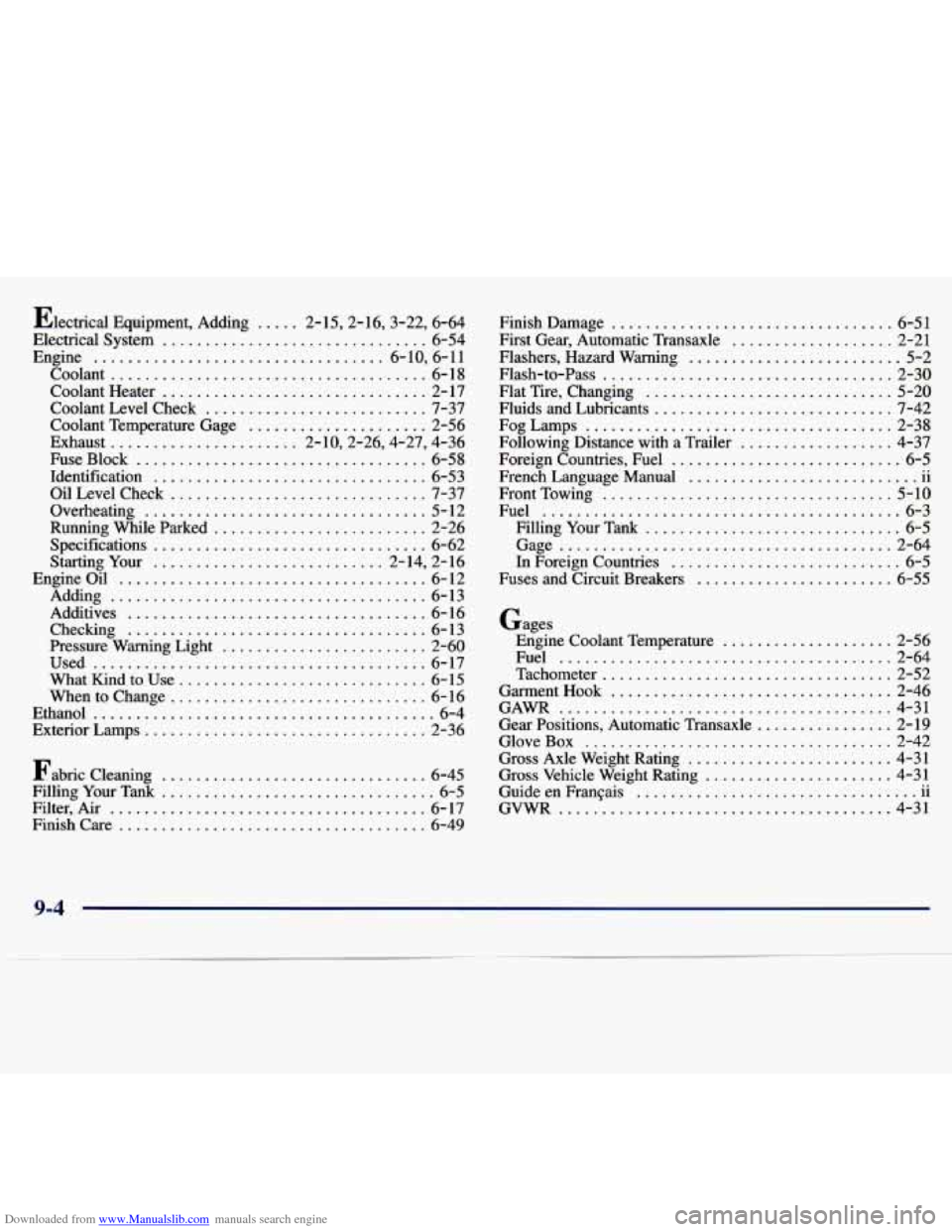
Downloaded from www.Manualslib.com manuals search engine Electrical Equipment. Adding ..... 2.15.2.16.3.22. 6.64
Electrical System
............................... 6-54
Engine
.................................. 6.10. 6.11
Coolant
..................................... 6-18
Coolant Heater
............................... 2-17
Coolant Levelcheck
.......................... 7-37
Coolant Temperature Gage
..................... 2-56
Exhaust
...................... 2.10.2.26.4.27. 4.36
FuseBlock
.................................. 6-58
Identification
................................ 6-53
Oil Level Check
.............................. 7-37
Overheating
................................. 5-12
Running While Parked
......................... 2-26
Specifications
................................ 6-62
Starting Your
........................... 2- 14. 2. 16
EngineOil .................................... 6-12
Adding
..................................... 6-13
Additives
................................... 6-16
Checking ................................... 6-13
Pressure Warning Light
........................ 2-60
Used
....................................... 6-17
What Kind to Use
............................. 6- 15
Ethanol ........................................ 6-4
Exterior Lamps
................................. 2-36
Whentochange
.............................. 6-16
Fabric Cleaning ............................... 6-45
FillingYourTank
................................ 6-5
Filter. Air
..................................... 6-17
Finishcare
.................................... 6-49 Finish Damage
................................. 6-51
First Gear. Automatic Transaxle
................... 2-21
Flashers. Hazard Warning
......................... 5-2
Flash-to-Pass .................................. 2-30
Flat Tire. Changing
............................. 5-20
Fluids and Lubricants
............................ 7-42
FogLmps
.................................... 2-38
Following Distance with a Trailer
.................. 4-37
Foreign Countries. Fuel
........................... 6-5
FrenchLanguageManual
11
FrontTowing .................................. 5-10
Fuel .......................................... 6-3
Filling Your Tank
.............................. 6-5
Gage
....................................... 2-64
In Foreign Countries
........................... 6-5
Fuses and Circuit Breakers
....................... 6-55
.. ...........................
Gages Engine Coolant Temperature
.................... 2-56
Fuel
....................................... 2-64
Tachometer
.................................. 2-52
Garment
Hook ................................. 2-46
GAWR
....................................... 4-31
Gear Positions. Automatic Transaxle
................ 2-19
GloveBox
.................................... 2-42
Gross Axle Weight Rating
........................ 4-31
Gross Vehicle Weight Rating ...................... 4-31
Guide en Frangais
11
GVWR ....................................... 4-31
.. .................................
9-4
Page 347 of 354
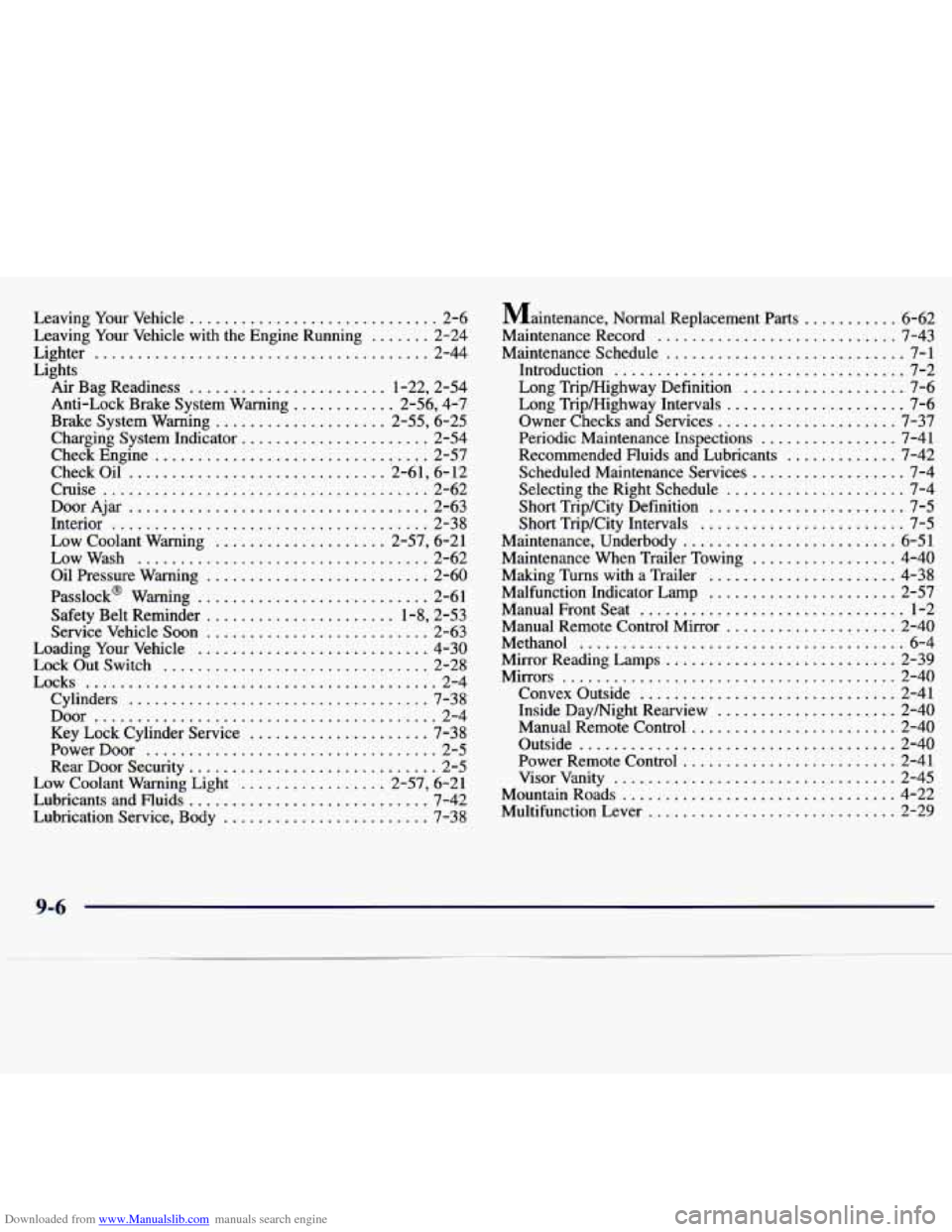
Downloaded from www.Manualslib.com manuals search engine Leaving Your Vehicle ............................. 2-6
Leaving Your Vehicle with the Engine Running
....... 2-24
Lighter
....................................... 2-44
Lights Air Bag Readiness
....................... 1.22. 2.54
Anti-Lock Brake System Warning
............ 2.56. 4.7
Brake System Warning
.................... 2.55. 6.25
Charging System Indicator
...................... 2-54
CheckEngine
................................ 2-57
CheckOil
.............................. 2.61. 6.12
Cruise
...................................... 2-62
DoorAjar
................................... 2-63
Interior
..................................... 2-38
Low Coolant Warning
.................... 2.57. 6.21
LowWash
.................................. 2-62
Oil Pressure Warning
.......................... 2-60
Passlock@ Warning
........................... 2-6 1
Safety Belt Reminder
...................... 1.8. 2.53
Service Vehicle
Soon .......................... 2-63
Loading Your Vehicle ........................... 4-30
Lock Out Switch
............................... 2-28
Locks
......................................... 2-4
Cylinders
................................... 7-38
Door
........................................ 2-4
Key Lock Cylinder Service
..................... 7-38
PowerDoor
.................................. 2-5
Rear Door Security
............................. 2-5
Low Coolant Warning Light
................. 2.57. 6.21
Lubricants and Fluids ............................ 7-42
Lubrication Service. Body
........................ 7-38 Maintenance.
~ormal Replacement parts ........... 6-62
Maintenance Record
............................ 7-43
Maintenanceschedule
............................ 7-1
Introduction
.................................. 7-2
Long Tripmighway Definition
................... 7-6
Long Tripmighway Intervals
..................... 7-6
Owner Checks and Services
..................... 7-37
Periodic Maintenance Inspections
................ 7-41
Recommended Fluids and Lubricants
............. 7-42
Scheduled Maintenance Services
.................. 7-4
Selecting the Right Schedule
..................... 7-4
Short TripKity Definition ....................... 7-5
Short TripKity Intervals ........................ 7-5
Maintenance. Underbody
......................... 6-51
Maintenance When Trailer Towing
................. 4-40
Making Turns with a Trailer
...................... 4-38
Malfunction Indicator Lamp
...................... 2-57
ManualFrontSeat
............................... 1-2
Manual Remote Control Mirror .................... 2-40
Methanol
...................................... 6-4
Mirror Reading Lamps ........................... 2-39
Mirrors
....................................... 2-40
Convex Outside
.............................. 2-41
Inside Daymight Rearview
..................... 2-40
Manual Remote Control
........................ 2-40
Outside
..................................... 2-40
Power Remote Control
......................... 2-41
Visorvanity
................................. 2-45
Mountain Roads
................................ 4-22
Multifunction Lever
............................. 2-29
9-6